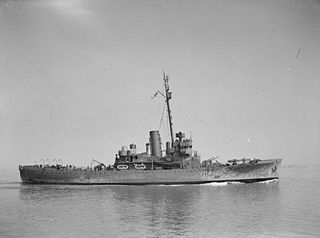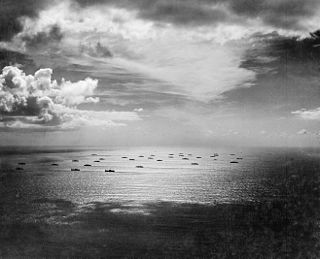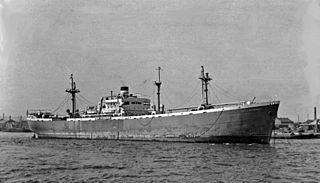
The HX convoys were a series of North Atlantic convoys which ran during the Battle of the Atlantic in the Second World War. They were east-bound convoys and originated in Halifax, Nova Scotia from where they sailed to ports in the United Kingdom. They absorbed the BHX convoys from Bermuda en route. Later, after the United States entered the war, HX convoys began at New York.

This is a timeline for the Battle of the Atlantic (1939–1945) in World War II.

USS Cushing (DD-376) was a Mahan-class destroyer in the United States Navy before and during World War II. She was the third Navy ship named for Commander William Barker Cushing (1842–1874).

HMCS Saguenay was a River-class destroyer that served in the Royal Canadian Navy (RCN) from 1931 to 1945.

SS Timothy Bloodworth was a standard Liberty ship built for the United States Maritime Commission during World War II. The vessel was built by Delta Shipbuilding Company of New Orleans in 1943. She was named in honor of Timothy Bloodworth, an American teacher who made muskets and bayonets during the American Revolutionary War, then went on to become a statesman in North Carolina.

SS John Stagg was a tanker-type (Z-ET1-S-C3) Liberty ship built at the Delta Shipbuilding Company, New Orleans, Louisiana, during World War II. She was named after John Stagg (1864–1915), who was President of Alabama Presbyterian College for Men.
SS John B. Lennon was an American Liberty ship in World War II. The ship was built by the J.A. Jones Construction shipyard at Brunswick, Georgia; sponsored by Mrs. F.R. Bustin, and launched on 22 December 1943.

HMCS Moncton was a Flower-class corvette that served in the Royal Canadian Navy during the Second World War. She served on both coasts of Canada. She is named after Moncton, New Brunswick.

SS James Longstreet was a Liberty ship built in the United States during World War II. Named after the Confederate general James Longstreet, she entered service in 1942, but was wrecked in a storm on 26 October 1943 and was subsequently used as a target hulk by the United States Navy.

The Banff-class sloop was a group of ten warships of the Royal Navy. Built as United States Coast Guard Lake-class cutters, in 1941 these ships were loaned to the Royal Navy as antisubmarine warfare escort ships. The transfers took place at the Brooklyn Navy Yard; the sloops were manned for transport to Britain by personnel from the damaged battleship Malaya which was under repair there.

USS Surprise (PG-63), the fourth American naval ship of the name, was a Temptress-class patrol gunboat during World War II. She was built as the British Flower-class corvette HMS Heliotrope, and was in service with the Royal Navy during the first years of the Battle of the Atlantic. She was loaned to and operated by the United States Navy from 1942–1945. After World War II, she was sold as a merchant vessel and ended her life in the Chinese navy as Lin I.
HMS Arabis was a Flower-class corvette of the Royal Navy. The ship was commissioned into the Royal Navy as HMS Arabis. She was transferred to the United States Navy in 1942, serving as USS Saucy. Returned to the United Kingdom in 1945, she was recommissioned into the Royal Navy as HMS Snapdragon.
Belgian Airman was a 6,959-ton cargo ship which was built by Harland & Wolff Ltd, Glasgow in 1941 for the Ministry of War Transport (MoWT). She was launched as Empire Ballantyne and transferred to the Belgian Government in 1942. She was sunk by a German U-boat on 14 April 1945.

The UG convoys were a series of east-bound trans-Atlantic convoys from the United States to Gibraltar carrying food, ammunition, and military hardware to the United States Army in North Africa and southern Europe during World War II. These convoys assembled in Hampton Roads near the mouth of Chesapeake Bay and terminated in various North African locations as Axis forces retreated from 1942 through 1945.
Belgian Crew was a 7,048 GRT cargo ship which was built in 1942 by Sir W G Armstrong, Whitworth & Co (Shipbuilders) Ltd, Newcastle upon Tyne as Empire Claymore for the Ministry of War Transport (MoWT). She was transferred to the Belgian Government in 1943 and renamed Belgian Crew. In 1946 she was sold to Compagnie Maritime Belge and renamed Capitaine Parlet. In 1960 she was sold to Hong Kong and renamed Ardenode. A further sale to Panama in 1966 resulted in her being renamed Tynlee. She served until 1969, when she was scrapped.
Convoy HX 300 was the 300th of the numbered series of World War II HX convoys of merchant ships from Halifax to Liverpool. It started its journey on 17 July 1944 and was the largest convoy of the war, comprising 166 ships.
HX 237 was a North Atlantic convoy of the HX series which ran during the Battle of the Atlantic in World War II. It was one of several convoy battles that occurred during the crisis month of May 1943.

The BX convoys were a World War II series of convoys across the Gulf of Maine from Boston to HalifaX. These convoys were escorted by the Western Local Escort Force (WLEF) of the Royal Canadian Navy to protect coastal shipping in transit between North American loading ports and trans-Atlantic convoy assembly points in Nova Scotia.
SS William Grayson was a Liberty ship built in the United States during World War II. She was named after William Grayson, a soldier, lawyer, and statesman from Virginia. Grayson was a delegate to the Confederation Congress from 1785 to 1787. He helped to pass the Northwest Ordinance, including a provision that forbade slavery in the Northwest Territory. He was one of the first two US Senators from Virginia, and belonged to the Anti-Federalist faction, he was also the first member of the United States Congress to die while holding office.

SS Ben H. Miller was a British merchant ship of World War II. A Liberty ship built in the United States in 1943, she was bareboat chartered to the British Ministry of War Transport, with Ellerman and Papayanni as managers. Sold to her managers after the war, she was renamed SS City of Shrewsbury in 1947. Resold in 1959, she became the Compagnia de Navigazione Arcoul's SS Marucla, and was scrapped in 1969. Her original namesake was Ben H. Miller.











